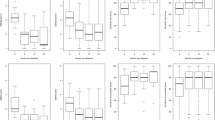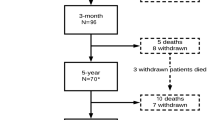Abstract
Purpose
The aim of this prospective observational cohort study was to evaluate long-term outcomes in patients with mild-to-moderate lumbar spinal stenosis (LSS) and to analyse the predictors of clinical outcomes.
Methods
A group of 53 patients were re-examined after a median period of 139 months. Evaluations were made of subjective clinical outcome, objective clinical outcome and its predictors, any correlation between subjective and objective outcome, and the development of changes in radiological and electrophysiological parameters after 12 years.
Results
Satisfactory objective and subjective clinical outcomes were recorded in 54.7 and 43.4 % of patients, respectively. No statistically significant correlation between objective and subjective clinical outcome was found (Spearman coefficient = 0.225, p = 0.132). Patients with isolated unsatisfactory subjective outcome exhibited the highest Functional Comorbidity Index of all subgroups. Electrophysiological and radiological findings did not demonstrate statistically significant changes after 12-year follow-up. Multivariate logistic regression confirmed only the lowest transverse diameter of spinal canal ≦13.6 mm as an independent predictor of unsatisfactory clinical outcome (OR = 5.51).
Conclusions
Satisfactory objective and subjective clinical outcomes were disclosed in about half of the patients with mild-to-moderate LSS in a 12-year follow-up. The number of comorbid diseases had an unfavourable effect on subjective evaluation of clinical outcome. The lowest transverse diameter of spinal canal proved to be the only independent predictor of deterioration of clinical status in LSS patients.



Similar content being viewed by others
Abbreviations
- AP:
-
Anteroposterior
- BMI:
-
Body mass index
- CT:
-
Computed tomography
- EMG:
-
Electromyography
- FCI:
-
Functional Comorbidity Index
- LL:
-
Lower limb
- LSS:
-
Lumbar spinal stenosis
- MRI:
-
Magnetic resonance imaging
- NASS:
-
North American Spine Society
- NC:
-
Neurogenic claudication
- NIS-LSS:
-
Neurological impairment score in lumbar spinal stenosis
- NRS:
-
Numerical rating scale
- OR:
-
Odds ratio
- ODI:
-
Oswestry Disability Index
- ROC:
-
Receiver operating characteristic
References
Kreiner DS, Shaffer WO, Baisden JL et al (2013) An evidence-based clinical guideline for the diagnosis and treatment of degenerative lumbar spinal stenosis (update). Spine J 13:734–743
Benoist M (2002) The natural history of lumbar degenerative spinal stenosis. Joint Bone Spine 69:450–457
Johnsson KE, Rosen I, Uden A (1992) The natural course of lumbar spinal stenosis. Clin Orthop Relat Res 279:82–86
Amundsen T, Weber H, Nordal HJ, Magnaes B, Abdelnoor M, Lilleas F (2000) Lumbar spinal stenosis: conservative or surgical management? A prospective 10-year study. Spine 25:1424–1435
Atlas SJ, Deyo RA, Keller RB et al (1996) The Maine Lumbar Spine Study, part III. 1-year outcomes of surgical and nonsurgical management of lumbar spinal stenosis. Spine 21:1787–1794
Atlas SJ, Keller RB, Robson D, Deyo RA, Singer DE (2000) Surgical and non surgical management of lumbar spinal stenosis: four-year outcomes from the Maine Lumbar Spine Study. Spine 25:556–562
Atlas SJ, Keller RB, Wu YA, Deyo RA, Singer DE (2005) Long-term outcomes of surgical and nonsurgical management of lumbar spinal stenosis: 8 to 10 year results from the maine lumbar spine study. Spine 30:936–943
Hurri H, Slätis P, Soini J et al (1998) Lumbar spinal stenosis: assessment of long-term outcome 12 years after operative and conservative treatment. J Spinal Disord 11:110–115
Simotas AC, Dorey FJ, Hansraj KK, Cammisa F Jr (2000) Nonoperative treatment for lumbar spinal stenosis: clinical and outcome results and a 3-year survivorship analysis. Spine 25:197–203
Weinstein JN, Tosteson TD, Lurie JD et al (2008) Surgical versus nonsurgical therapy for lumbar spinal stenosis. N Engl J Med 358:794–810
Weinstein JN, Tosteson TD, Lurie JD et al (2010) Surgical versus nonoperative treatment for lumbar spinal stenosis four-year results of the Spine Patient Outcomes Research Trial. Spine 35:1329–1338
Malmivaara A, Slätis P, Heliövaara M et al (2007) Surgical or nonoperative treatment for lumbar spinal stenosis? A randomized controlled trial. Spine 32:1–8
Slätis P, Malmivaara A, Heliövaara M et al (2011) Long-term results of surgery for lumbar spinal stenosis: a randomised controlled trial. Eur Spine J 20:1174–1181
Kovacs FM, Urrútia G, Alarcón JD (2011) Surgery versus conservative treatment for symptomatic lumbar spinal stenosis: a systematic review of randomized controlled trials. Spine 36:E1335–E1351
Siebert E, Prüss H, Klingebiel R, Failli V, Einhäupl KM, Schwab JM (2009) Lumbar spinal stenosis: syndrome, diagnostics and treatment. Nat Rev Neurol 5:392–403
Strömqvist B, Fritzell P, Hägg O, Jönsson B, Sanden B, Swedish Society of Spinal Surgeons (2013) Swespine: the Swedish spine register: the 2012 report. Eur Spine J 22:953–974
Tsutsui S, Kagotani R, Yamada H, Hashizume H, Minamide A, Nakagawa Y, Iwasaki H, Yoshida M (2013) Can decompression surgery relieve low back pain in patients with lumbar spinal stenosis combined with degenerative lumbar scoliosis? Eur Spine J 22:2010–2014
Sobottke R, Aghayev E, Röder C, Eysel P, Delank SK, Zweig T (2012) Predictors of surgical, general and follow-up complications in lumbar spinal stenosis relative to patient age as emerged from the Spine Tango Registry. Eur Spine J 21:411–417
Strömqvist F, Jönsson B, Strömqvist B, Swedish Society of Spinal Surgeons (2012) Dural lesions in decompression for lumbar spinal stenosis: incidence, risk factors and effect on outcome. Eur Spine J 21:825–828
Haig AJ, Tong HC, Yamakawa KS et al (2006) Predictors of pain and function in persons with spinal stenosis, low back pain, and no back pain. Spine 31:2950–2957
Micankova Adamova B, Vohanka S, Dusek L, Jarkovsky J, Bednarik J (2012) Prediction of long-term clinical outcome in patients with lumbar spinal stenosis. Eur Spine J 21:2611–2619
Micankova Adamova B, Vohanka S, Hnojcikova M, Okacova I, Dusek L, Bednarik J (2013) Neurological impairment score in lumbar spinal stenosis. Eur Spine J 22:1897–1906
Groll DL, To T, Bombardier C, Wright JG (2005) The development of a comorbidity index with physical function as the outcome. J Clin Epidemiol 58:595–602
Pearson A, Lurie J, Tosteson T, Zhao W, Abdu W, Weinstein JN (2012) Who should have surgery for spinal stenosis? Treatment effect predictors in SPORT. Spine 37:1791–1802
Aalto TJ, Malmivaara A, Kovacs F et al (2006) Preoperative predictors for postoperative clinical outcome in lumbar spinal stenosis: systematic review. Spine 31:E648–E663
Athiviraham A, Wali ZA, Yen D (2011) Predictive factors influencing clinical outcome with operative management of lumbar spinal stenosis. Spine J 11:613–617
Katz JN, Lipson SJ, Brick GW et al (1995) Clinical correlates of patient satisfaction after laminectomy for degenerative lumbar spinal stenosis. Spine 20:1155–1160
Sigmundsson FG, Kang XP, Jönsson B, Strömqvist B (2012) Prognostic factors in lumbar spinal stenosis surgery. Acta Orthop 83:536–542
Ng LC, Tafazal S, Sell P (2007) The effect of duration of symptoms on standard outcome measures in the surgical treatment of spinal stenosis. Eur Spine J 16:199–206
Conflict of interest
None.
Author information
Authors and Affiliations
Corresponding author
Rights and permissions
About this article
Cite this article
Adamova, B., Vohanka, S., Dusek, L. et al. Outcomes and their predictors in lumbar spinal stenosis: a 12-year follow-up. Eur Spine J 24, 369–380 (2015). https://doi.org/10.1007/s00586-014-3411-y
Received:
Revised:
Accepted:
Published:
Issue Date:
DOI: https://doi.org/10.1007/s00586-014-3411-y




